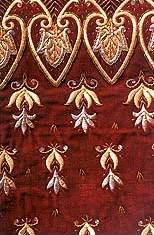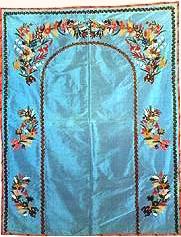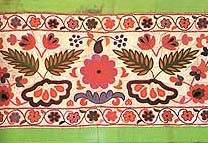Embroidery is one of the most ancient and popular kindsof woman's fine arts. In opinion of N.Vorobyev, its development was connected with seclusion of women, who seldom left the house and devoted their free time to the needlework. Unlike the Russians, Ukrainians, Maris and other peoples, the Tatars did not embroider clothes, but decorated household goods: towels, napkins, table cloths, coverlets and window curtains, rugs. Most of these things are connected to the interior decoration.
Furniture of the Tatar house had certain features. Normally, the house was not divided into rooms and overloaded with furniture, hence the appearance of skillfully embroidered curtains. The most valuable embroidery for years was stored in chests and was taken out only on occasions of big holidays.
The house became especially colorful during the wedding ceremony - everything was decorated by embroidery and loomworks of a bride. This custom demonstrating bride's diligence and skill is still alive in some village areas.
The embroidery also plays an important role in the first-born celebrating custom - a young mother gives towels to her relatives and neighbors.
|
 |  |
| Golden Embroidery on Velvet |  |
The embroidery was usually made on bright fabric - green, yellow, violet, vinous in twisted silk, gilt or silver cord, beads, pearls. Ornamental design of geometrical figures and plants was emphasized. Compositions of a garden in blossom had recognizable red poppies and yellow-eyed camomiles, tulips and pansies.
The Kazan towels embroidered in silver and gold chain-stitch on white silk were especially beautiful, famous outside the region.
Fancy weaving also connected with household was widespread. Ornamentation resembles Central Asian and Azerbaijan carpets, whereas the color spectrum (red and various shades of red) has no analogies. The majority of Tatar women were good at weaving, but the fabrics with complex and multi-color patterns usually were made by special village craftsmen.
|


